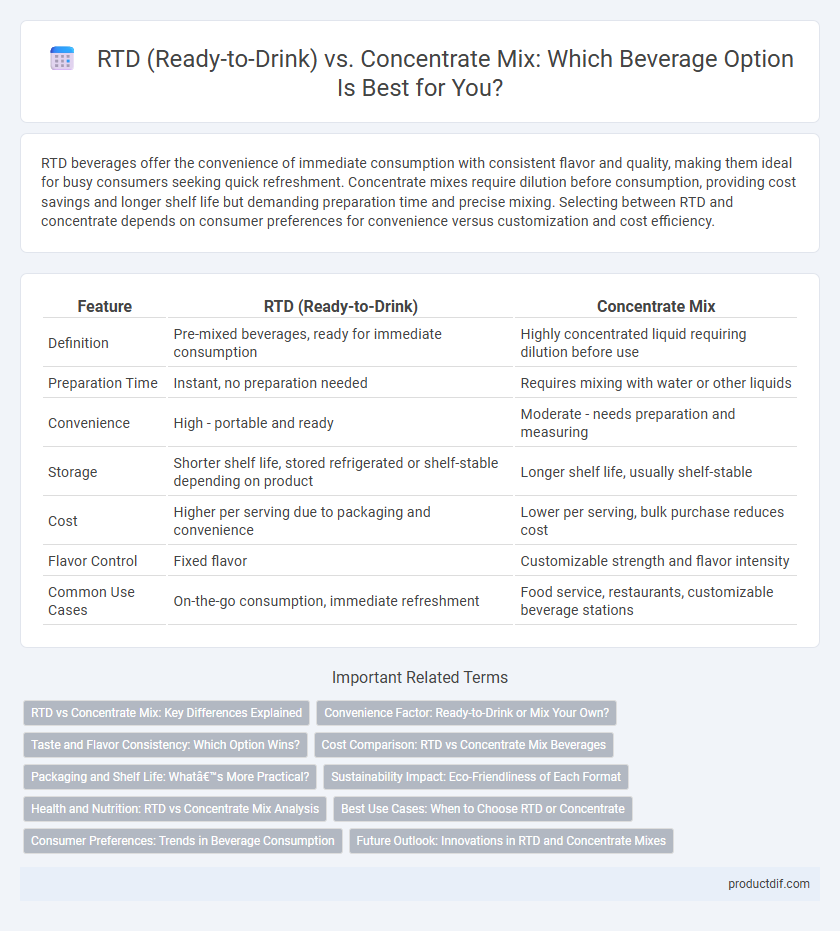RTD beverages offer the convenience of immediate consumption with consistent flavor and quality, making them ideal for busy consumers seeking quick refreshment. Concentrate mixes require dilution before consumption, providing cost savings and longer shelf life but demanding preparation time and precise mixing. Selecting between RTD and concentrate depends on consumer preferences for convenience versus customization and cost efficiency.
Table of Comparison
| Feature | RTD (Ready-to-Drink) | Concentrate Mix |
|---|---|---|
| Definition | Pre-mixed beverages, ready for immediate consumption | Highly concentrated liquid requiring dilution before use |
| Preparation Time | Instant, no preparation needed | Requires mixing with water or other liquids |
| Convenience | High - portable and ready | Moderate - needs preparation and measuring |
| Storage | Shorter shelf life, stored refrigerated or shelf-stable depending on product | Longer shelf life, usually shelf-stable |
| Cost | Higher per serving due to packaging and convenience | Lower per serving, bulk purchase reduces cost |
| Flavor Control | Fixed flavor | Customizable strength and flavor intensity |
| Common Use Cases | On-the-go consumption, immediate refreshment | Food service, restaurants, customizable beverage stations |
RTD vs Concentrate Mix: Key Differences Explained
Ready-to-Drink (RTD) beverages offer convenience and immediate consumption without preparation, making them ideal for on-the-go lifestyles, while concentrate mixes require dilution before drinking, allowing customization of flavor and strength. RTD products often have a shorter shelf life due to their ready-to-consume nature, whereas concentrate mixes benefit from longer storage potential because of their concentrated form. Nutritional content varies as RTDs typically contain added preservatives and sweeteners, contrasting with concentrate mixes that may retain more natural ingredients depending on formulation.
Convenience Factor: Ready-to-Drink or Mix Your Own?
Ready-to-Drink (RTD) beverages offer unmatched convenience with pre-mixed, portable options ideal for on-the-go consumption, eliminating the need for additional preparation. Concentrate mixes require manual dilution, providing customization but demanding time and access to mixing tools and water. Consumers prioritizing speed and ease favor RTD products, while those valuing control over flavor and strength often choose concentrate mixes.
Taste and Flavor Consistency: Which Option Wins?
RTD beverages offer superior taste and flavor consistency due to factory-controlled production processes that minimize variation, ensuring each serving matches the intended profile. Concentrate mixes may experience flavor degradation or inconsistency from dilution errors and shelf-life deterioration, impacting overall consumer satisfaction. For brands prioritizing reliable taste replication and premium sensory experience, RTD formats typically provide the winning solution.
Cost Comparison: RTD vs Concentrate Mix Beverages
RTD beverages typically incur higher production and packaging costs due to their convenience and individually sealed servings, whereas concentrate mixes reduce expenses by requiring dilution, minimizing shipping weight and storage space. Concentrate mixes allow volume purchasing and longer shelf life, making them more cost-effective for bulk consumption despite additional preparation time by the consumer. The cost per serving of concentrate mixes is generally lower, appealing to budget-conscious consumers and businesses aiming to optimize expenses without sacrificing beverage quality.
Packaging and Shelf Life: What’s More Practical?
RTD beverages offer convenience with single-serve packaging and extended shelf life, making them ideal for on-the-go consumption and retail display. Concentrate mixes require less packaging volume and reduce transportation costs but often need refrigeration after opening and have shorter shelf lives. Balancing packaging sustainability and shelf stability, RTD formats tend to be more practical for immediate use, while concentrates suit bulk usage and cost-efficiency.
Sustainability Impact: Eco-Friendliness of Each Format
RTD (Ready-to-Drink) beverages often have higher packaging waste due to single-use containers, increasing their environmental footprint compared to concentrate mixes, which reduce waste by requiring consumers to mix smaller, concentrated volumes at home. Concentrate mixes minimize carbon emissions linked to transportation by significantly lowering volume and weight during shipment, enhancing supply chain sustainability. The reuse potential and compact packaging of concentrate formats contribute to better resource efficiency and reduced landfill impact, making them a more eco-friendly option in beverage consumption.
Health and Nutrition: RTD vs Concentrate Mix Analysis
RTD beverages often offer consistent portion control and clear nutritional labeling, facilitating better calorie and sugar monitoring compared to Concentrate Mixes, which may require additional ingredients that increase caloric intake. RTD products typically include fortified vitamins and minerals, enhancing overall health benefits without extra preparation. Concentrate Mixes can contain higher levels of preservatives and added sugars to maintain shelf stability, potentially impacting nutritional quality negatively.
Best Use Cases: When to Choose RTD or Concentrate
RTD (Ready-to-Drink) beverages are ideal for consumers seeking convenience, portability, and quick consumption without preparation, making them perfect for on-the-go lifestyles, outdoor events, and busy schedules. Concentrate mixes are best suited for cost-efficient bulk preparation, customizable flavor strength, and extended shelf life, appealing to foodservice providers and households that prioritize volume control and reduced packaging waste. Choosing between RTD and concentrate depends on consumer preference for immediate consumption versus flexibility in serving sizes and storage.
Consumer Preferences: Trends in Beverage Consumption
Consumer preferences in the beverage industry show a growing demand for RTD (Ready-to-Drink) products due to their convenience and time-saving attributes, appealing particularly to busy, on-the-go lifestyles. Concentrate mixes attract consumers looking for cost-effective, customizable beverage options with longer shelf life and smaller packaging footprint. Market trends indicate a surge in premium flavors and health-oriented ingredients in RTD formulations, while concentrates emphasize sustainability and reduced sugar variants.
Future Outlook: Innovations in RTD and Concentrate Mixes
The future of RTD beverages and concentrate mixes is driven by innovations in natural ingredients, functional benefits, and sustainable packaging. Advances in formulation technology enable enhanced flavor profiles and extended shelf life while meeting consumer demand for convenience and health-conscious options. Integration of smart packaging and personalized nutrition solutions is poised to transform the RTD and concentrate mix market landscape.
RTD (Ready-to-Drink) vs Concentrate Mix Infographic

 productdif.com
productdif.com